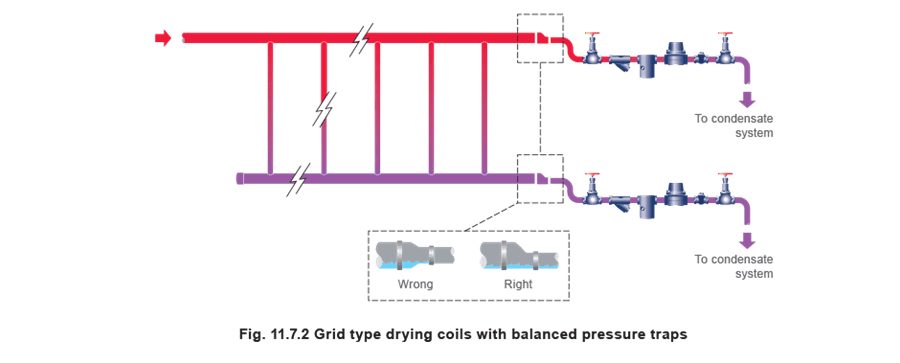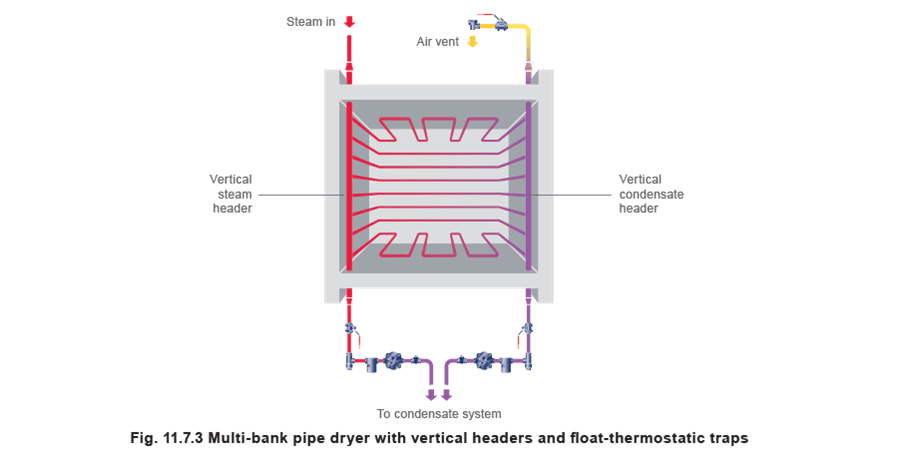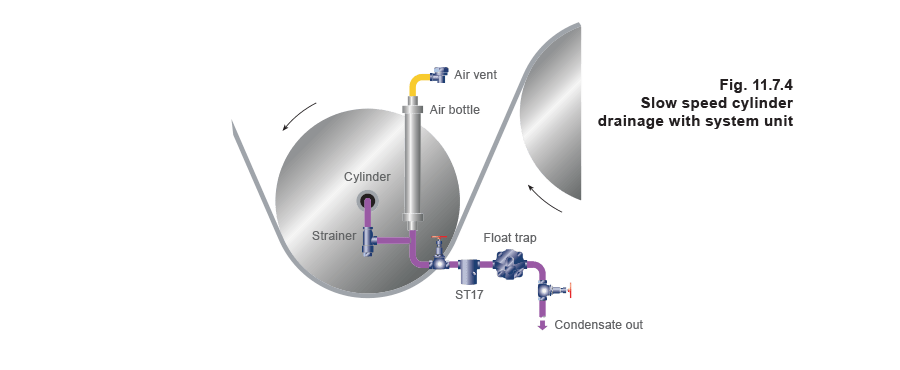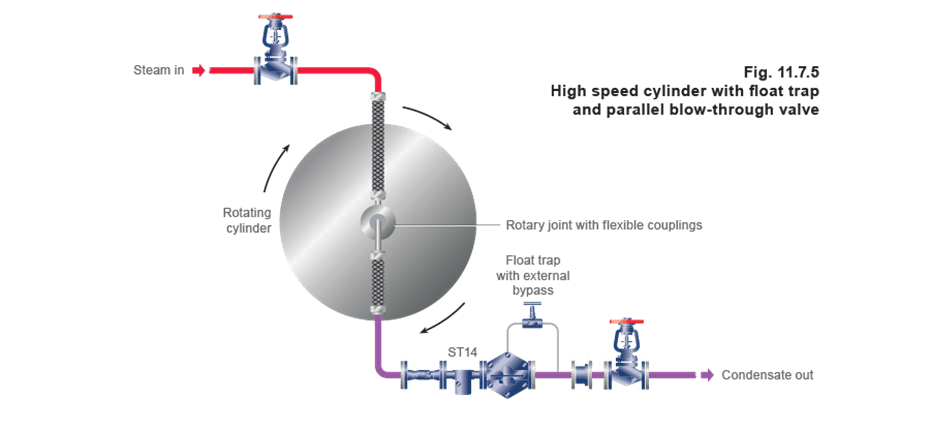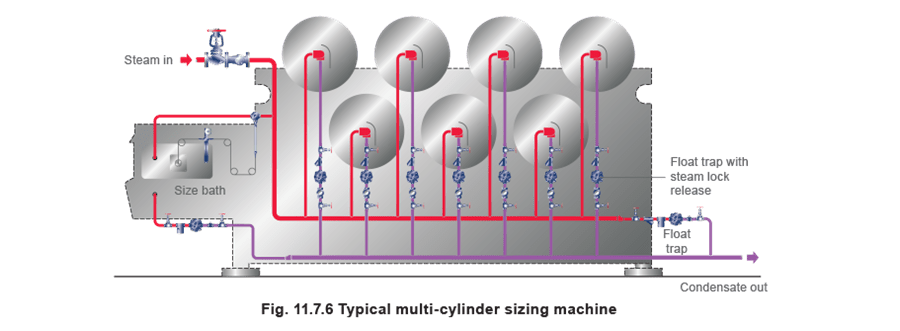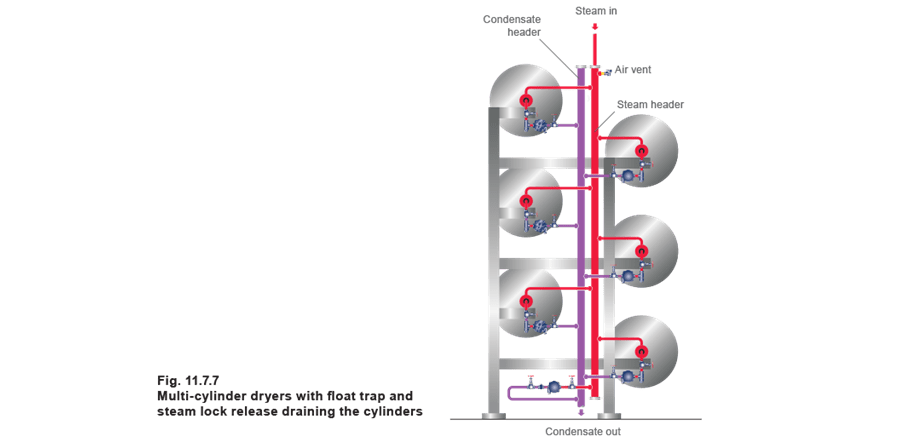Steam Traps and Steam Trapping

Contents
Selecting Steam Traps - Industrial Dryers
Selection tables and advice on trap selection for a range of different processes are included in this tutorial, including multi-bank pipe dryers and rotating cylinders.
Industrial Dryers
A - Best choice, B - Acceptable alternative,
1 (parallel air vent).
Hot air dryers
Many industrial substances are dried using hot air. The machines take various forms, but can either consist of heater batteries through which air is forcibly drawn before being blown on to the wet material, or pipes over which air naturally convects (Figure 11.7.1). The need for draining and air venting is the same as for heater batteries used for space heating.
Drying coils
These can be continuous or in grid form, horizontal or vertical. Continuous coils should be short with an adequate fall in the direction of steam flow so that condensate can easily reach the drain point. They can then be drained using a float-thermostatic trap or a balanced pressure trap. If the condensate is lifted from the trap using coil pressure only, waterhammer may occur. Waterhammer is likely in grid coils unless all sections fall towards the drain point and the condensate then falls to a lower level. The same recommendations apply as for continuous coils. If thermodynamic or inverted bucket traps are used, an air vent bypassing the trap will shorten ‘start-up’ time. The inlet header should be drained separately, unless the cross pipes are level with the bottom of it, to allow free flow to the condensate header. Always use an eccentric reducer at the coil outlet (Figure 11.7.2).
Multi-bank pipe dryers
Examples of multi-bank pipe dryers are the older types of tentering and carbonising machines, and kilns used in the textile and wood treatment industries, (but which are now being replaced by steam heated hot air dryers).
At one time, very long, continuous runs of pipe were used, and because it was impossible to arrange for a proper fall and also due to sagging pipes, waterlogging and waterhammer were common. Where this arrangement still exists thermodynamic traps can be used with an air vent in parallel. Later machines of this type were divided into bays, and the improved layout reduced waterhammer. In these cases, float-thermostatic traps or balanced pressure thermostatic traps with stainless steel elements can also be used. They should be fitted outside the machine casing, but as close as possible to the end of the coil.
Where the heating surface consists of horizontal coils running between vertical headers, the top of the vertical condensate outlet header should be air vented separately. This will considerably reduce start-up times. The bottom of the vertical stem inlet header should also be drained (Figure 11.7.3).
Heated rotating cylinders
Heated rotating cylinders vary widely in size, speed and condensate handling arrangements, which may be by means of internal scoops or fixed or rotating syphon pipes. The latter are normally associated with high speed machines, and sometimes use a special blow-through system. (Refer to Figures 11.7.4 and 11.7.5).
Slow speed cylinders with scoops and fixed syphons should be trapped and air vented individually, each with an air bottle arrangement. This comprises a float-thermostatic trap with steam lock release, strainer, sight glass, air collector vessel, and air vent, assembled in various forms to fit different outlet nozzle arrangements. This arrangement allows good individual control of cylinder temperature where it is required. The sight glass can be used to set up the steam lock release valve.
On faster machines, there is a need for large amounts of blow-through steam to assist the flow of condensate out of the cylinder via the syphon tube. The float trap internal steam lock release cannot handle such large amounts, and an external bypass with needle valve will give better results.
Multi-cylinder sizing machines
Figure 11.7.6 shows how to drain and air vent a typical multi-cylinder textile sizing machine.
The steam manifold supplying the cylinders is drained by a float trap, or thermodynamic trap.
Float traps with steam lock release drain the cylinders. This compact arrangement is particularly suited to small combined inlet and outlet nozzles.
The size bath is usually heated either by direct steam injection or a steam coil and in both cases the supply should be regulated by a suitable temperature control. The coil should be drained by a float-thermostatic trap.
Multi-cylinder dryers
Modern vertical machines should, if possible, have the cylinders drained individually, using float traps with combined steam lock releases and air vent bypasses.
If the cylinders all drain into a vertical condensate manifold, use a float-thermostatic trap at the bottom and an air vent at the top of the manifold.
The steam inlet manifold should be similarly drained and air vented (Figure 11.7.7).



